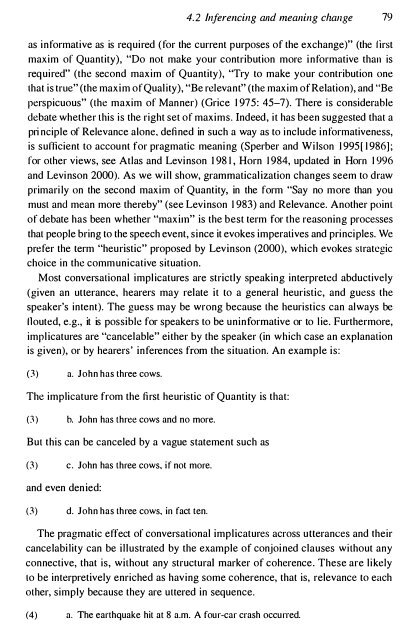Gram - SEAS
Gram - SEAS
Gram - SEAS
Create successful ePaper yourself
Turn your PDF publications into a flip-book with our unique Google optimized e-Paper software.
4.2 Inferencing an.d mean.ing change 79<br />
as informative as is required (for the current purposes of the exchange)" (the first<br />
maxim of Quantity), "Do not make your contribution more informative than is<br />
required" (the second maxim of Quantity), "Try to make your contribution one<br />
that is true" (the maxim of Quality), "Be relevant" (the maxim of Relation), and "Be<br />
perspicuous" (the maxim of Manner) (Grice 1975: 45-7). There is considerable<br />
debate whether this is the right set of maxims. Indeed, it has been suggested that a<br />
pri nciple of Relevance alone. defined in such a way as to include informativeness,<br />
is sufficient to account for pragmatic meaning (Sperber and Wilson 1995[ 1986];<br />
for other views, see Atlas and Levinson 1981, Horn 1984, updated in Horn 1996<br />
and Levinson 2000). As we will show, grammaticalization changes seem to draw<br />
primarily on the second maxim of Quantity, in the form "Say no more than you<br />
must and mean more thereby" (see Levinson 1983) and Relevance. Another point<br />
of debate has been whether "maxim" is the best term for the reasoning processes<br />
that people bring to the speech event, since it evokes imperatives and principles. We<br />
prefer the term "heuristic" proposed by Levinson (2000), which evokes strategic<br />
choice in the communicative situation.<br />
Most conversational implicatures are strictly speaking interpreted abductively<br />
(given an Ullerance. hearers may relate it to a general heuristic, and guess the<br />
speaker's intent). The guess may be wrong because the heuristics can always be<br />
flouted, e.g., it is possible for speakers to be uninformative or to lie. Furthermore,<br />
implicatures are "cancelable" either by the speaker (in which case an explanation<br />
is given), or by hearers' inferences from the situation. An example is:<br />
(3) a. John has three cows.<br />
The implicature from the first heuristic of Quantity is that:<br />
(3)<br />
b. John has three cows and no more.<br />
But this can be canceled by a vague statement such as<br />
(3) c. John has three cows. if not more.<br />
and even denied:<br />
(3) d. John has three cows. in fact ten.<br />
The pragmatic effect of conversational implicatures across ullerances and their<br />
cancelability can be illustrated by the example of conjoined clauses without any<br />
connective, that is, without any structural marker of coherence. These are likely<br />
to be interpretively enriched as having some coherence, that is, relevance to each<br />
other, simply because they are uttered in sequence.<br />
(4) a. The earthquake hit at 8 a.m. A four-car crash occurred.
















